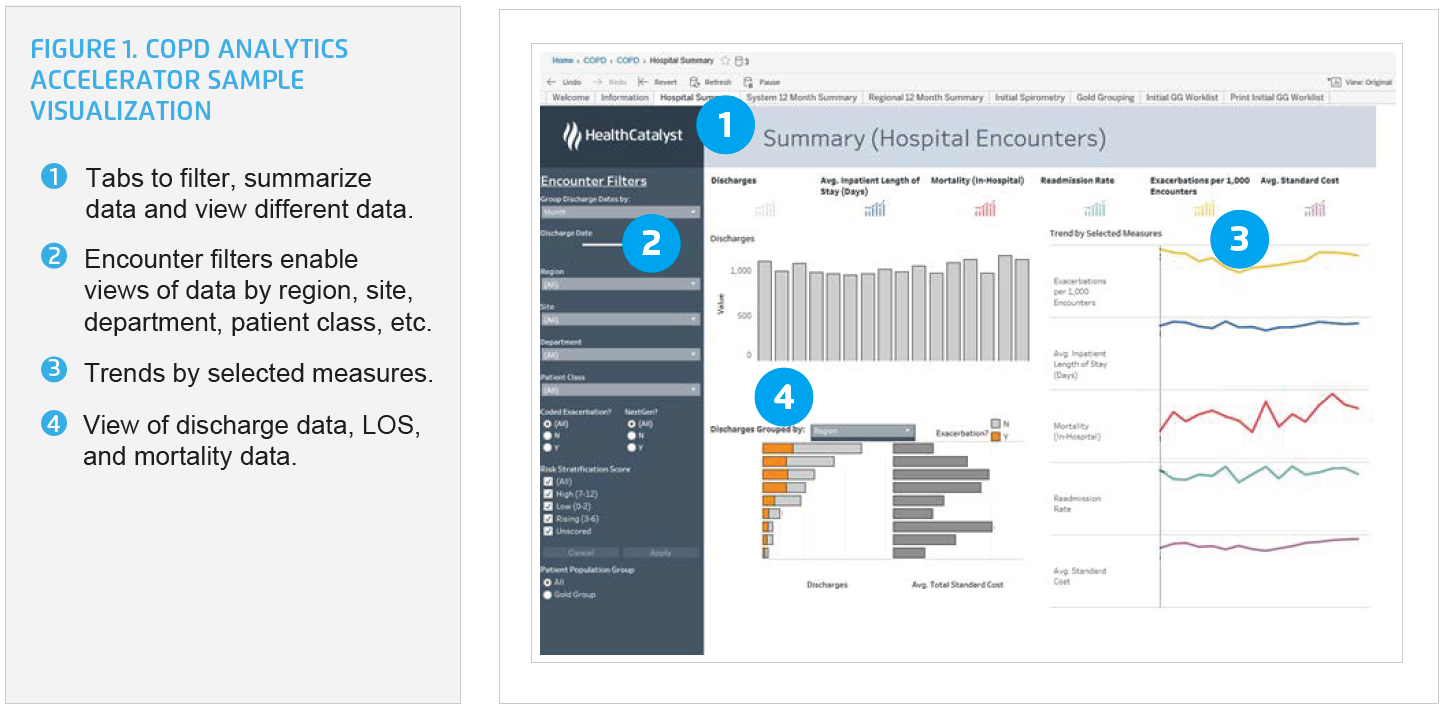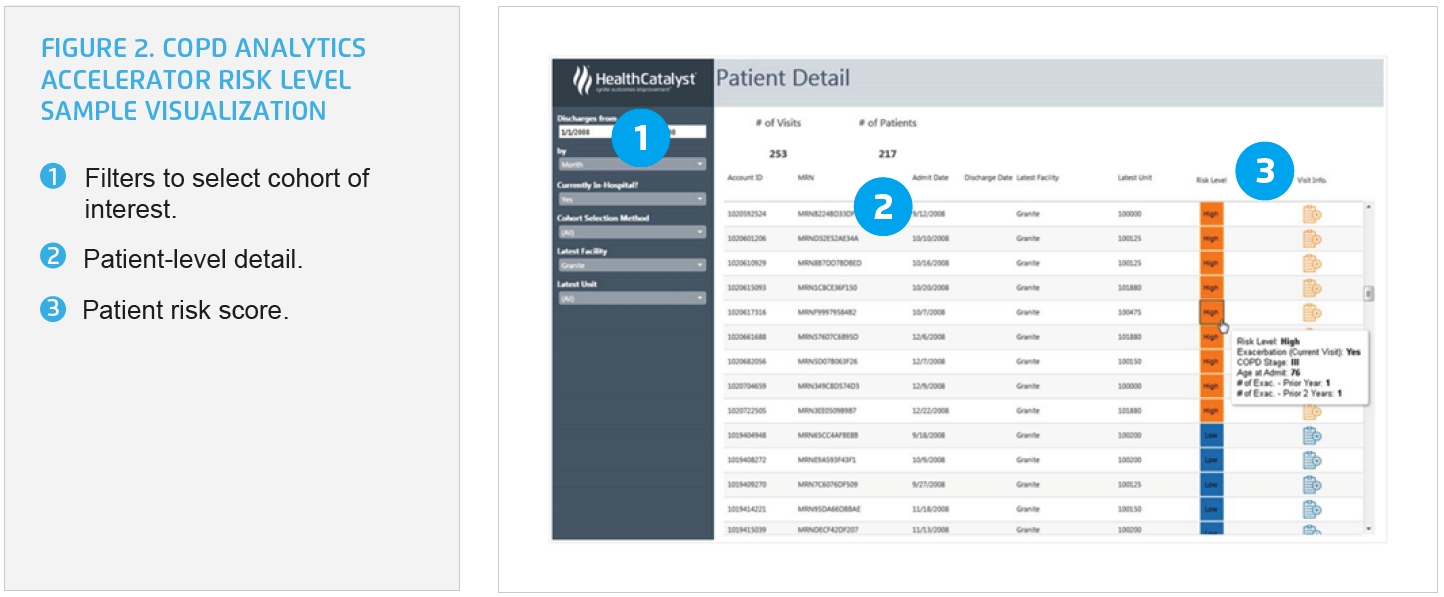Closed-Loop Analytics Improves Workflow and Efficiency

- 83 percent relative reduction in the number of clicks and keyboard interactions.
- 150 hours saved annually for the registered nurses and care coordinators providing care to patients with COPD, the result of closed-loop analytics and click reduction.
- Significant improvement in documentation of process aims for high-risk patients.
For every hour of direct patient care they provide, primary care physicians spend nearly two hours on EMR tasks. Registered nurses also spend a substantial amount of their time, up to 45 percent, in the EMR as part of their regular workflow. Using closed-loop analytics integrated into its EMR and COPD application, UnityPoint Health has automated and improved workflow, gained operational efficiency, and improved staff satisfaction.
DISPARATE DATA PUTS HEALTHCARE ORGANIZATIONS AT A DISADVANTAGE
The need for integrated, consumable data in healthcare has never been greater. Combining data from disparate sources into useful insights means having the right data at the right time—in the hands of the right person—so that it can be leveraged to improve patient outcomes and improve clinical and business operations.
The need for integrated, readily accessible, and actionable data embedded into workflows is underscored by the fact that clinicians spend a significant part of their workday interacting with the EMR. For example, primary care physicians spend nearly two hours on EMR tasks per hour of direct patient care, adding up to a whopping six hours per ten-hour shift spent in the EMR.1 Registered nurses also spend a substantial amount of their time, up to 45 percent, in the EMR.2
Many healthcare organizations inefficiently and ineffectively utilize their data, which leads to errors and increased costs. The data needed for decision making is often difficult to access, and especially difficult to access in real-time as a part of clinician workflows.3 Closed-loop analytics turns data into action, bridging the gap between data that informs end users what’s happening with a patient or population, and data that tells these end users how they can intervene. It can improve the workflow and decrease the non-value-added time clinicians spend in the EMR, improving data access and use without altering their workflow.
UnityPoint Health is committed to providing outstanding care across Iowa, western Illinois, and southern Wisconsin. The UnityPoint Health network includes hospitals, clinics, and home care services, with over 4.5 million annual patient visits, providing a full range of care to patients and families using innovative advancements to deliver the best outcome for every patient, every time.
TIME-CONSUMING AND INEFFICIENT WORKFLOW
The care teams needed the ability to monitor and evaluate population health outcomes in aggregate and needed to be able to easily focus in on individual patients of interest. Before the new tool was introduced, the process included care teams generating reports and manually reviewing the data to determine which patients should be prioritized for follow-up. The care teams spent a significant amount of time reviewing and managing patient lists and reports. The health system needed a solution that would provide care teams with easy access to the required information.
CLOSED-LOOP ANALYTICS IN HEALTHCARE: TURNING ACTION INTO INSIGHT
Recognizing the potential to improve the effectiveness of its population health efforts and its processes for managing patients with COPD, UnityPoint Health leveraged the Health Catalyst® Data Operating System (DOS™) and a robust suite of analytics applications, including the Chronic Obstructive Pulmonary Disease analytics accelerator, and closed-loop analytics to improve the accessibility of data, to improve COPD population health management and the associated workflows.
Closed-loop analytics is a solution that integrates timely, consumable data and delivers it in an actionable state to serve the purpose of outcomes improvement. It reduces data latency and barriers to data accessibility, and delivers analytics that can be immediately acted upon, while reducing the number of clicks required to effectively document patient care.
The COPD analytics accelerator, with integrated closed-loop analytics, supports care teams in their effort to effectively manage patients with COPD. For the first time, care teams can use the analytics accelerator to quickly and easily visualize population-level outcomes and drill into detailed patient-specific data (see Figure 1).

Rather than receiving a list of patients with COPD who were recently discharged, patients at risk for readmission, and patients with both COPD and diabetes—or clicking around in the EMR to attempt to find the data they need—the COPD team can simply open the analytics accelerator embedded within the EMRand access all of the population health and patient detail data they need, all in one place.

The analytics accelerator provides a more complete view of patients than the view provided by discrete screens within the EMR. Clinicians can easily access detailed patient information and determine if the patient has received the needed care or identify if additional care items are required. For example, using the analytics accelerator embedded within the EMR, clinicians can confirm if a patient received a pulmonary function test, and if not, clinicians are able to use the closed-loop analytics functionality to click the patient medical record number and open the chart.
They quickly and easily arrive in the patient’s EMR and place the order for the test—all with just a few clicks. After completing the order entry, clinicians can easily click back into the analytics accelerator embedded within the EMR—they no longer need to write notes about needed follow-up activities, toggle between screens, or log out of one system and log into another.
With closed-loop analytics, UnityPoint Health has the ability to more effectively monitor important care process measures and can evaluate the impact of care on outcomes in near real-time. The organization is now able to monitor these measures in aggregate for the entire population and easily identify specific patients for whom the care process measures have not yet been met. This includes monitoring of:
- Pulmonary function tests.
- Pulmonary function test results documented in the EMR.
- Assessment and documentation of the patient’s symptom score.
- Accurate documentation and count of annual COPD exacerbations.
- COPD stage/score—a critical piece of information required by providers to help guide treatment plans.
RESULTS
Using closed-loop analytics integrated into its EMR and the COPD analytics accelerator, UnityPoint Health has improved its ability to effectively monitor and improve population health, automate and improve its workflows, and decrease the potential for error associated with manual workflows. All of this has come with improved staff satisfaction. In addition, UnityPoint Health has achieved the following:
- Substantially improved insight regarding patient needs, and has observed an 83 percent relative reduction in the number of clicks and keyboard interactions required to effectively apply the actionable insights generated from the analytics application.
- 150 hours saved annually for the registered nurses and care coordinators providing care to patients with COPD, the result of closed-loop analytics and click reduction.
The organization has experienced significant improvement over 18 months, in the number of patients receiving the expected COPD care, including:
- 50 percent relative improvement in the number of patients receiving pulmonary function testing.
- 73 percent relative improvement in the number of patients with the results of their pulmonary function testing documented in the EMR.
- 380 percent relative improvement in the number of patients who had their symptom score documented.
- 930 percent relative improvement in the number of patients who had the annual number of COPD exacerbations documented.
- 3,580 percent relative improvement in the number of patients who had a COPD stage/score assigned.
“We worked with Health Catalyst to embed their analytics tool into our EMR, and now the care team for patients with COPD can directly access the patient record for more in-depth analysis, review, and care planning. It helps them identify efficient and effective interventions for high-risk patients with COPD.”
– Judy Beswick, Director of Clinical Innovation/Transformation
WHAT’S NEXT
UnityPoint Health plans to continue to expand closed-loop analytics into other patient populations, integrating the EMR and analytics application workflow, enabling it to further improve population health.
REFERENCES
- Arndt, B. G., Beasley, J. W., Watkinson, M. D., Temte, J. L., Tuan, W. J., Sinsky, C. A., & Glichrist, V. J., (2017). Tethered to the EMR: Primary care physician workload assessment using EMR event log data and time motion observations. Ann Fam Med, 15(5), 419-426.
- Bureau of Labor Statistics. (2019). Occupational employment statistics. May 2018 national industry-specific occupational employment and wage estimates.
- Celi, L. A., Marshall, J. D., Lai, Y., & Stone, D. J. (2015). Disrupting electronic health records systems: The next generation. JMIR Medical Informatics, 3(4), e34.
This website stores data such as cookies to enable essential site functionality, as well as marketing, personalization, and analytics. By remaining on this website you indicate your consent. For more information please visit our Privacy Policy.